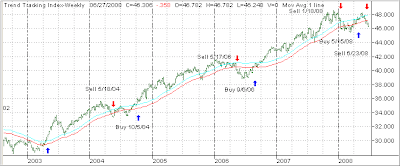 In the past, I have referred to a variety of Al Thomas’s articles, since he happens to be one of the few who calls it as he sees it, no matter who he may offend in the process. I like this kind of thinking and appreciated his recent piece titled “Cash is a Position,” a topic which I have addressed on many occasions. Let’s listen in:
In the past, I have referred to a variety of Al Thomas’s articles, since he happens to be one of the few who calls it as he sees it, no matter who he may offend in the process. I like this kind of thinking and appreciated his recent piece titled “Cash is a Position,” a topic which I have addressed on many occasions. Let’s listen in:
Cash Is A Position
You will never hear that from any broker. Even the discount brokers won’t utter it. Almost every investor I speak with tells me his account has lost value over the past several months. Most say they have lost about 20%. It is going to get worse.
Brokers tell investors that mutual funds are “safe”.
Safe from what? Certainly not from seeing your money disappear. They never want you to sell. Why? There are many hidden fees even in no-load mutual funds. Between the fund and the brokerage company they are skimming about 2% of your money every year. There are a few that do have less than ½% expenses, but they are few and far between.
In a brokerage company, if a broker had his clients go to cash he would be fired. That piddling 1% skim means a great deal to the office manager. His office is rated on the total amount of funds. If one of his brokers suddenly had his clients transfer several million to a money market account the next day the broker would not have a desk.
Mutual fund managers are paid by the total amount in the fund and NOT by how well or how much they make for shareholders.
When a broker gets his registration he is given two manuals. The first has all the rules and regulations of the Securities and Exchange Commission (SEC). He must not violate any of these or he will lose his license.
The second is a sales manual on how to open new accounts. That is basically every broker’s job – bring in new money and lots of it.
There is no third manual. What third manual?
That is how to make money for customers, but more important how to protect a client’s money from loss. During the 2000 – 2003 crash that saw the NASDAQ evaporate 78%, most brokers were in shock.
They asked their boss what can we do. He either did not know or was not allowed to tell them. Brokerage companies will sacrifice their customers rather than try to help them preserve their capital. Seems pretty horrible. That’s life on Wall Street. The current credit crisis is all about the greed for money. The little guy in a local office that you know just doesn’t know that he doesn’t know. He was never taught. It is not going to change.
It is your money. YOU must protect it. There are two choices. Find a fee based broker or financial planner (and most of them don’t know how to come in or out of the rain) or YOU must have an exit strategy.
Check the portfolio of the broker to see what he did in 2000 to 2003. Make him give references.
You may not like what I said. You will wish you did when it comes to retirement time.
I have been singing a similar song for a long time in preparation for exactly the times we are in right now. Markets go down a lot faster than they go up and, given the bursting of the bubble economy along with the fact that our domestic Trend Tracking Index (TTI) now clearly sits in bear market territory, 100% cash (money market) should be your position. The only exception would be, if you have taken measures to hedge your portfolio such as we did.





